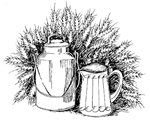SLOWING THE PROGRESSION OF SARCOPENIA
 As we age, we all experience loss of muscle mass and its accompanying loss of strength. This process generally begins in our 40’s and continues throughout the rest of our lives. It is called sarcopenia. Starting around age 40, we lose an estimated 8% of muscle mass per decade. After age 70, muscle mass decreases by about 15% per decade.
As we age, we all experience loss of muscle mass and its accompanying loss of strength. This process generally begins in our 40’s and continues throughout the rest of our lives. It is called sarcopenia. Starting around age 40, we lose an estimated 8% of muscle mass per decade. After age 70, muscle mass decreases by about 15% per decade.
Muscles are constantly undergoing breakdown and restoration. With aging, the formation of new muscle declines while muscle breakdown continues at its usual pace. The progression of sarcopenia is a primary factor in the risk for falls leading to fractures and other injuries. Sarcopenia is known to be a major reason for nursing home placement and hospital admissions among the elderly.
While exercise is a must in helping prevent age related muscle loss and slowing down the progression of sarcopenia, exercise must be accompanied by the regular consumption of a number of vitamins, minerals, amino acids and other nutrients on a regular basis. It is widely known that protein is a critical nutrient in the building and maintenance of muscle tissue. Not so well known is the role of two other nutrients that have been shown to rebuild lost muscle tissue, including such loss in aging individuals. One such nutrient is Beta-hydroxy beta-methylbutyrate (HMB) and the other is vitamin D3.
HMB and muscle:
HMB is made in the body from the amino acid leucine. Leucine is not made in the body and must be obtained from proteins in the diet. HMB is essential to maintaining balance between anabolism (muscle buildup) and catabolism (muscle breakdown). Levels of HMB diminish in the body as we age. This leads to a decline in muscle mass and strength.
Knowing that inactivity for only a short period of time can lead to muscle loss, several studies have shown that supplementation with HMB significantly reduced the loss of muscle during periods of inactivity. In one study, healthy older adults voluntarily submitted to ten days of complete bed rest. For five days prior to the bed rest the volunteers were twice daily given either a placebo powder or a powder providing 1.5 grams of HMB. This continued during the bed rest and for a period thereafter. The placebo group experienced a reduction in total lean body mass (primarily muscle tissue) of about 4.4 pounds. Those receiving the HMB lost only 0.37 pounds.
In another study, a group of 70-year-old individuals participated in a resistance exercise program five days a week for eight weeks. Participants in this program took either one gram of HMB or a placebo three times a day. After eight weeks, the HMB group experienced an increase in lean body mass of 1.76 pounds. The placebo group actually lost 0.44 pounds. The HMB group also lost more body fat than the placebo group.
Muscle strength and movement is also dependent on the proper function of the nervous system which deteriorates with age. HMB has been shown to prevent some age related changes in the nerve cell connections and facilitate the growth of new nerve branches.
Vitamin D3 and muscle:
Vitamin D appears in two forms. It is available from plants as vitamin D2 ergocalciferol and from animal sources as vitamin D3 cholecalciferol. Both are converted by the liver into calciferol which is then used by the body to regulate calcium and phosphorus absorption. Vitamin D3 is the more biologically active form of this nutrient and has been shown to be twice as effective in producing calciferol. Our body makes D3 by exposure to ultraviolet light from the sun. In addition to its role in regulating the use of calcium and phosphorus in the body, vitamin D3 has been shown to improve muscle strength and performance, maintain a healthy immune system, regulate cell growth and differentiation, and facilitate normal cardiovascular function.
In one study, researchers randomly had women take 1000 International Units of vitamin D3 or placebo on a daily basis for nine months. After the nine months of supplementation, those taking the vitamin D3 experienced a 25.3% increase in leg muscle strength while those in the placebo group lost 6.8% of muscle tissue.
A 2014 analysis of data from 30 randomized controlled trials involving more than 5,600 people showed that vitamin D3 had a significant positive effect on overall muscle strength. Since the average American tends to have low vitamin D levels, supplementation with vitamin D3 is highly recommended.
Regular exercise (especially resistive exercise) and a nutrition dense diet are vital to slow down the progression of sarcopenia. Adding HMB and vitamin D3 to your supplement program can help slow this process as well. At Milk ‘N Honey we carry a product from the company Life Extension called “Muscle Strength & Restore Formula.” This product provides a daily serving of three grams of HMB and 1000 International Units (IU’s) of Vitamin D3.